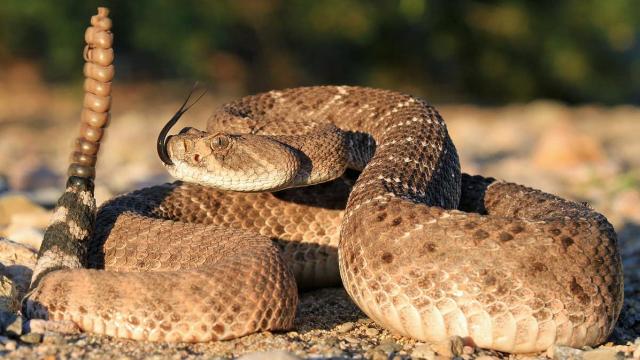Snakes use their venom for both offensive and defensive purposes, but new research suggests this ability initially appeared as a strategy for attacking prey, not for self-defence.
An unresolved question about the evolutionary origin of snake venom is whether these limbless reptiles initially acquired their toxic powers for offensive or defensive purposes. That their venom arose for defensive purposes is hardly a stretch of the imagination, considering the amount of human suffering these venomous snakes cause on a regular basis.
Figures from the World Health Organisation show that approximately 2.7 million people are bitten by venomous snakes each year, of which anywhere from 81,000 to 138,000 will go on to die. Snakes, needless to say, do not prey on humans, but they will strike when threatened.
So snakes clearly use their venom for self-defence. But did venom first appear as a protective measure, and later evolve as a way to subdue prey, or was it vice-versa? New research published in the suitably named journal Toxins tackles this very question, finding that venom likely evolved for prey and not defence.
“We know that snake venom is used primarily for foraging; for overpowering and killing prey,” said Wolfgang Wüster, a co-author of the new study and a researcher at Bangor University, in a press release. “However, we also know that snakes use their venom in self-defence—that’s why so many people get bitten, and sometimes killed, by venomous snakes worldwide. We wanted to investigate whether defence was a driver in venom evolution.”
Venom, to be effective as a defensive weapon, has to act fast and with sufficient severity if it’s to work as a deterrent. Bee stings are a good example.
For the new study, Wüster and his colleagues studied a variety of venomous snake bites as they’re perceived by humans, both in terms of the time it took for the pain to set in and the severity of the pain.
To get the required data, the scientists conducted an online survey of people who regularly handle—and get bitten by—venomous snakes, including zookeepers, ecologists, and herpetologists. These snake victims were asked to rate their experience of pain during the first one to five minutes after being bitten, which they did using a scale from 1 to 10, and then after five minutes. Respondents were also asked to rate the maximum amount of pain they felt at any point, such as a couple of hours later.
“The purpose was to focus mostly on the timescale of pain development rather than the actual pain levels themselves,” explained Wüster and study co-author Kevin Arbuckle from Swansea University in an article penned for The Conversation. “The rationale was that while the intensity of pain experienced will vary greatly between people, the timing of when pain develops should be more consistent. Different people may consider a bee sting to be a minor nuisance or unbearable, but everyone agrees that it hurts immediately.”
In total, the researchers received 368 responses from people across the world, chronicling 584 individual bites from 192 species of venomous snakes.
Survey results showed that very few snakes have venom that packs an instantaneous punch. Only 14.5 per cent of bite victims experienced distracting levels of pain within the first five minutes, a window of time the scientists referred to as the “ecologically crucial” period for the venom to serve as a defensive weapon. Roughly 31 per cent of respondents said the pain was severe after the five-minute mark, and surprisingly, 54.6 per cent “reported never experiencing pain great enough to make normal activities impossible,” wrote the authors in the study.
The scientists took this as evidence that venom emerged primarily for offensive, rather than protective, purposes.
“Our results suggest little evidence for widespread evolution of venoms driven by their use in defence, though interesting exceptions likely exist such as the defensive use of venom ‘spitting’ in some cobras, and these specific cases deserve further study,” explained Arbuckle in the Bangor University press release.
“Even though we might have expected defending your life to be more important than feeding, it turns out that natural selection for diet does seem to be the main driver of venom evolution in snakes,” added Wüster.
There are a few limitations to this study, however.
First, and as the authors wrote in the study, “the pain experienced by different individuals bitten by the same species varied immensely, not only in its absolute level but also in its trajectory.” Obviously, it would’ve been nice to see consistency here, but it’s fair to say different people experience pain differently, as pain can be subjective. Yes, the authors said the pain trajectory was a better measure than the severity of the pain itself, but there’s something unsatisfying about the lack of consensus here.
In addition, the new paper doesn’t really tell us much about how nonhuman animals respond to venomous snake bites. For all we know, smaller animals, such as birds, raccoons, coyotes, and even other snakes, experience the pain of venomous snake bites far quicker and with more intensity than humans. Future research should consider this possibility.
